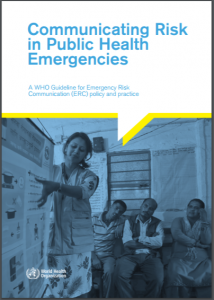Communicating Risk in Public Health Emergencies
The recommendations in these guidelines provide overarching, evidence-based guidance on how risk communication should be practiced in an emergency. The recommendations also guide countries on building capacity for communicating risk during health emergencies.
The guidelines aim to provide WHO Member States, partners and stakeholders involved in emergency preparedness and response with evidence-based, up-to-date, systems-focused guidance on:
- Approaches for building trust and engaging with communities and affected populations
- Approaches for integrating risk communication into existing national and local emergency preparedness and response structures, including building capacity for risk communication as required of all WHO Member States by the International Health Regulations (2005)
- ERC practice – from strategizing, planning, coordinating, messaging, channeling different methods and approaches of communication and engagement, to monitoring and evaluation – based on a systematic assessment of the evidence on what worked and what did not work during recent emergencies.
This manual was developed for policy- and decision-makers responsible for managing emergencies, particularly the public health aspects of emergencies, and practitioners responsible for risk communication before, during and after health emergencies. Other groups expected to use these guidelines are: frontline responders; local, national and international development partners; civil society; the private sector; and all organizations, private and public, involved in emergency preparedness and response.
Last modified: October 29, 2021
Language: English

